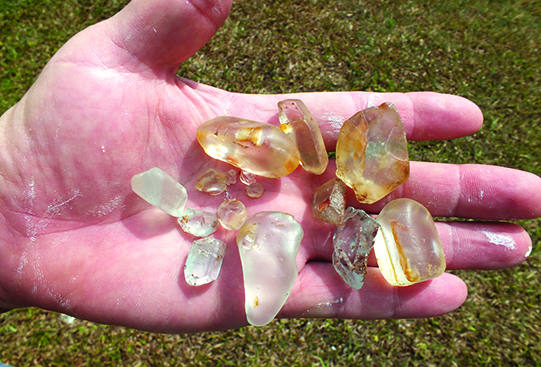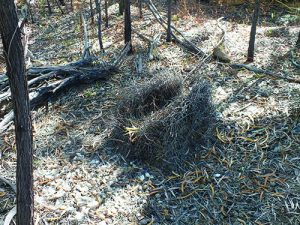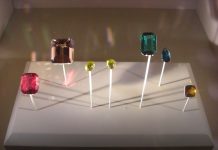
Family trips hunting for topaz and diamonds in Australia by the dinner plate full leads to a lifetime passion for rockhounding.
Having caught the gemstone-hunting bug early in my life chasing sapphires at the Anakie gem fields (Central Queensland, Australia in the early 1970s), I have always loved the thrill of the hunt for shiny things. They don’t have to be valuable shiny things, just a tiny piece of God’s creation that nobody had ever seen before I laid my hand on it.
Learning Specking

As kids, we weren’t much into the hard yakka (labor) of digging and sieving, but soon learned the fine art of ‘specking’, which is walking around with eyes glued to the ground in front of us, picking up the bits left behind by more ambitious, or perhaps more discerning, fossickers (searcher for rocks and minerals).
A few of these finds were jewelry-quality though most were not, but that didn’t devalue them in our eyes or make the process of looking for them any less enjoyable. Dirt, sunshine, and freedom to explore the pristine bushland that we camped in with no amenities whatsoever, but when you are a ten-year-old, who needs showers?
Family Move Leads to More Gem Locations
The family moved to Cairns when I started secondary school, and it took us a few years to discover that there were gemstones to be found in North Queensland also, and where they could be lawfully found.
We started making family trips to the Mt. Gibson topaz fields in the early 1980s, by which time I had found a good man to marry, and he caught the gem-hunting bug on his very first trip despite none of us having much idea of what we were looking for.
We had a couple of elderly long-wheelbase Land Rovers that carried us and all the camping gear. The vehicles steadfastly chugged their way up the mountain, albeit with no air-conditioning and springs (shocks) that were built for durability, not for comfort. That was all we needed for a promising long weekend!
Fast forward some 30 years, and in the company of our adult children and their significant others, we were still eager to find more lovely topaz and headed to another fossicking area called O’Brien’s Creek, 37km (22 miles) north of Mt. Surprise and just over 400km (248 miles) from Cairns.

The Atherton Tablelands
After leaving tropical Cairns on the coast, two routes lead to the Atherton Tablelands. This area is known for beef/dairy farms and fields of sugarcane, maize, potatoes, peanuts, fruit, and vegetables of all kinds.
Travelers are advised to follow the signs that point toward Herberton/Ravenshoe and enjoy the sight of the majestic wind turbine farm and the dairying district of Ravenshoe. A must-remember destination on the path to the dig site on the return trip is the hot thermal springs at Innot Hot Springs – heavenly for a good long soak after a day’s digging.
The route takes travelers through the tin mining area of Mt. Garnet. This distance of 192km (119 miles) takes about 2.5 hours to travel from Cairns. The next leg of the journey involves another 62km (38 miles) southwards through the quaint town of Mt. Garnet, along the Kennedy Development Road through the 40-Mile Scrub with its unusual Queensland Bottle Trees. Then it’s westward to Mt. Surprise township. This road is all-weather bitumen (asphalt) and the journey takes travelers another 73km (45 miles). The final turn off the main highway brings rockhounds toward the O’Brien’s Creek fossicking area, which is well-identified at the western end of the town, just opposite the local police station.
Accommodations
The town of Mt. Surprise has several motels and good caravan parks. However, the O’Brien’s Creek camping area (which is situated squarely on the banks of Elisabeth Creek) with its hot showers and toilets, and large campsites on the banks of the beautiful creek abounding with birdlife, is undoubtedly a choice location. Camping is not permitted within the boundaries of the designated fossicking area.

The camp area is amazingly pleasant, with Elizabeth Creek flowing most of the year, an unusual occurrence in the harsh environment of this country. During school holidays, families set up camp, relax and paddle canoes along the creek.
Twitchers (birdwatchers) and wildlife enthusiasts make the journey to camp here specifically to watch the apostle birds, bower birds, and blue-aced honey-eaters. They make themselves at home around your campsite, with kookaburras and butcherbirds waiting for, or stealing, a snack from unguarded plates. Mother galahs feed their babies while crimson-wing and rosella parrots feed on grass seeds almost at your feet. Big flocks of black cockatoos land for a late afternoon drink on the sandy river banks.
Digging for Topaz
Gem-quality stones were plentiful and were measured by the dinner plate full in the early days of the fossicking field, but constant picking over has reduced the finds considerably. This area was extensively mined for tin in the late 1800s, using only hand tools, with little mechanical assistance and often little or no water.
These dedicated miners found tin, but they saw no value in the shiny chunks of topaz they turned over in the process, so they left them behind in the tailings and mullock heaps. These are what fossickers chase today. There are still active mining leases in the area, of which few are worked consistently, but they remain out of bounds to fossickers.
If you are traveling in a conventional vehicle, fields of the Designated Fossicking Area (DFA) signposted ‘Tourmaline Gully’ and ‘Crystal Gully’ are generally easily accessed and the first places to visit. The access road runs along the western side of O’Brien’s Creek, and numerous tracks are leading into the sandy creek beds where fossickers have been at work.
Dry sieving in the creek can produce lovely topaz, quartz crystals, tin crystals (cassiterite), and the rarer aquamarine, especially after the wet-season rain scours the creek banks. Rockhounds do have to expend considerable effort removing large rocks, tree roots, and other obstacles to process new ground.
Geology Contributes to Rock Shape

These finds are generally more waterworn and rounded than stones found in the higher areas, which are sharper-edged and more crystalline in appearance. Evidence of digging in the river bank is visible everywhere, so visitors are advised to choose an appealing place and heft the shovel. As the DFA is part of a working cattle station, fossickers need to be aware of wandering stock, and the fertilizer they leave in their wake.
Since 1968, the Australian Government has set aside ‘Designated Fossicking Areas’ throughout Australia that permit people to fossick for gemstones and gold. Most of these areas are on private land, and landholders allow people to hunt gems in these areas providing they do not interfere with farming activities. A fossickers license is required in Queensland whether the fossicker is using private land or digging in a designated fossicking area. These licenses can be bought online at the ‘Department of Natural Resources, Mines and Energy’ for around $75 AU (around $50 U.S.) for a year.
Visitors to the area will see the proof of many eager people having worked the top of the hill. This area produces lovely smoky quartz crystals, and the locals swear they have found
tourmaline here also.
If you have a 4WD and are not afraid to get it slightly battered, then the Blue Hills and McDonald Creek fields are the place to go. Being less accessible, not so much fossicking activity has taken place here as in other sites. The road was initially built for use by tin miners and kept in good condition. However, once
the tin mining declined, the constant use, no maintenance, and numerous wet seasons have made the road pretty rough – especially on the two jump-ups (short, steep rises).
These fields are where quality blue topaz can be found in the dry creek beds and by digging at the top of hills. Topaz crystals are also collected along the track toward the Six-Mile Creek area. Just walking over the ground that looks undisturbed is worthwhile for specking glints of topaz sitting on the soil surface, exposed by the elements.
The locals advise that moving a boulder and digging a little on the uphill side may bag you a gem, as topaz is weightier than the average creek gravel and tends to get lodged in back-wash crevices during flood events. A member of our family found a perfect aquamarine crystal here. It was sitting on the surface of the soil, catching her eye This crystal was since valued at between $1,200 and $1,800 as a rough specimen, all in a good day’s work!
The Difference Between Topaz & Diamonds
I mentioned to a Cairns geologist with whom I had previously worked that I was going fossicking at O’Brien’s Creek. He said, “Keep your eyes open for diamonds while you are there.” I asked, “How would you tell the difference between a diamond and a topaz?” His reply was, “You will certainly know the difference when you see it.”
That conversation reminded me of an incident that occurred when I worked as a GIS Officer (mapping) for an exploration company in Ravenshoe, North Queensland. A ‘tin scratcher’ came to the office to ask the geologists if a stone he had found might be a diamond?
Of course, everyone’s eyes lit up as we all gathered around the weather-beaten hand that held the find. Yes, though small, it was confirmed to be a diamond. The was suitably vague about where he had found it and replied, “out near Mt. Surprise.” That was in the late 1980s, and his words remained in the back of my mind since.
In 2016, while researching the history of tin miners who worked along Elizabeth and O’Brien’s Creeks, and Angor, a tin mining shantytown of the 1880s in the Mt. Surprise area, I came across a public company report that summarized all previous reports written for this region. It immediately caught my interest, and I admit to doing a little chicken dance around my office when the summary included reports of companies specifically looking for diamonds. The summary report was written in December 1993 by a consulting geologist for Northern Diamonds Pty Ltd. His report stated that up until 1993, 53 diamonds had been reportedly found in colors ranging from white to yellow. The sizes ranged from 0.3 carats to 5 carats, the latter being the largest noted.

During the 1980s, another geologist had contacted the people who had found the first 26 diamonds. He sent some of these to South Africa to be tested to determine their quality. The results were that they were certainly diamonds but not of top gem quality.
This was enough encouragement for exploration companies to continue to search the area of Elizabeth and O’Brien’s creeks until the late 1990s. Currently, diamond exploration is still relatively active in northern Queensland, especially in the Cape York goldfields region.
Discussing Origins of Diamonds
I questioned each geologist or miner I have spoken to about the area about where they thought the diamonds originate.
Confusingly, each geologist has a slightly different theory. The Cairns geologist said the Elizabeth Creek diamonds were formed as far away as the Palmer River in the Cape York area and migrated along the waterways. The consulting geologist who wrote the 1993 report speculated that they were local and traveled the Red River lineament. He stated that in his opinion, all the diamonds found up to that date ‘were associated with a 50km long relict Cretaceous placer, which parallels Elizabeth Creek’. He goes on to say, ‘The placer is characterized by well-rounded quartz pebbles known locally as ‘pigeon egg wash.’ We did find some of these ‘pigeon eggs’ on the top of a hill in the fossicking area, which may have journeyed along ancient paleochannels (riverbeds), and this speaks of significant geological upheaval activity.

The areas of Elizabeth and O’Brien’s Creeks are identified as being one of several relict Cretaceous mineralized river systems. The systems contain cassiterite, ilmenite, zircon, monazite, garnet, and gold. The Elizabeth Creek system is the only one to date known to potentially contain diamonds. Early mining reports reveal that before the1930’s, this area produced 376 tons of cassiterite from alluvium in creeks and gullies, and mining remained spasmodic until 1985 when the price of tin crashed.
The Elizabeth Creek system occurs as a semi-discontinuous group of sand ridges north of and parallels to the present Elizabeth Creek. The major alluvial workings in the area have been for cassiterite in the streams draining the sand ridges over its entire exposed length. The extensive basalt flows from the Undarra Cone to the east have touched this area on its southern boundary.
A word of warning here before venturing on a diamond-only search. Since 1976, only 53 diamonds have been reported as being found, though it is likely that some were not reported, or not immediately identified as being diamonds. The majority were sourced west of the fossicking area, but some came from O’Brien’s Creek within the DFA.
The diamonds in the fossicking area were found in the river bed of O’Brien’s Creek by tin miners and local people living in the area, who honestly believe there is the potential for more to be found. One local who has a Mineral Lease (ML) just outside the DFA, said that he found a diamond while working for a tin mining company in the 1980s.
Each trip to O’Brien’s Creek sees us bring home loads of unknown stones in the event they may be diamonds, as finding one, according to the locals, is entirely possible.
Most of our ‘treasures’ turn out to be chuckers (chuck them away) or leaverites (leave them right there), but it always surprises us when we wash these stones, and a considerable amount proves to be lovely topaz, sometimes blue. On the last trip, along with our aquamarine crystal, we found a small aquamarine chip by specking.
As our research suggests, diamonds have been found in ‘them thar hills’ and your chance of finding one is as good as the next person’s. As an added incentive for the relic-hunting readers, I found some R. Bell & Co match tins in the ruins of a tin mining camp in this area.
The harsh, hot climate makes short work of the temporary, low-cost living quarters the mining camps provided back in the mining heyday. Finding such a site, searching, and waving a metal detector proves there are interesting treasures to be found in the most unexpected places, and it is sad to see little bits of our history is being lost to the elements.
This story about hunting for Topaz and Diamonds appeared in a previous issue of Rock & Gem magazine. Click here to subscribe! Story and Photos by Jenni Clark & Leigh Twine.














